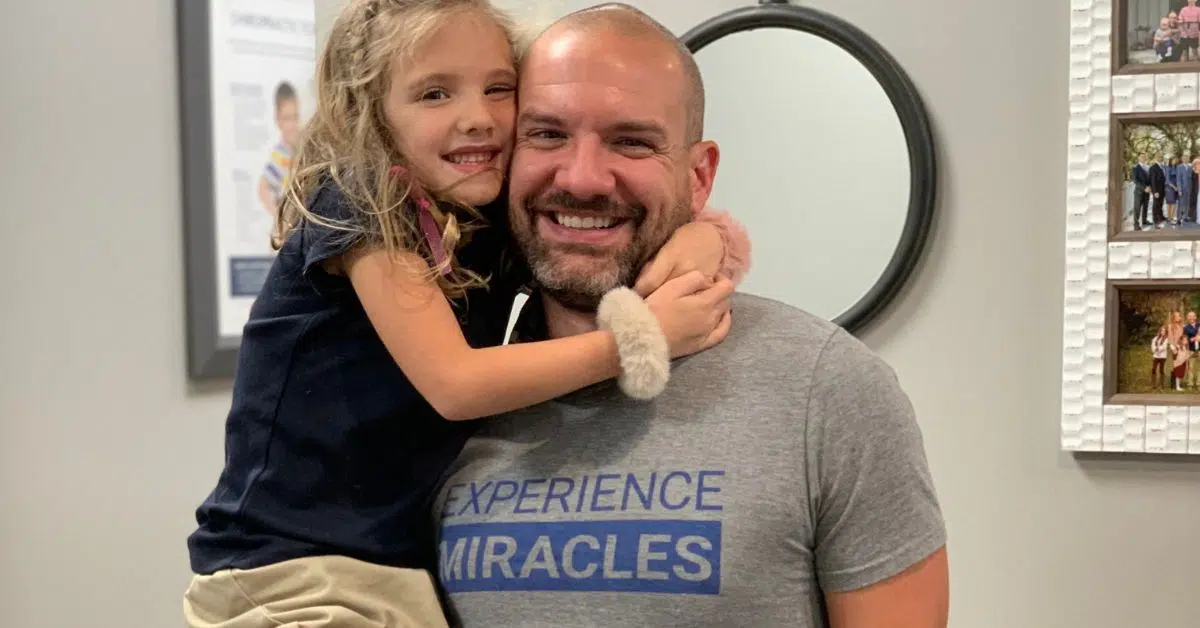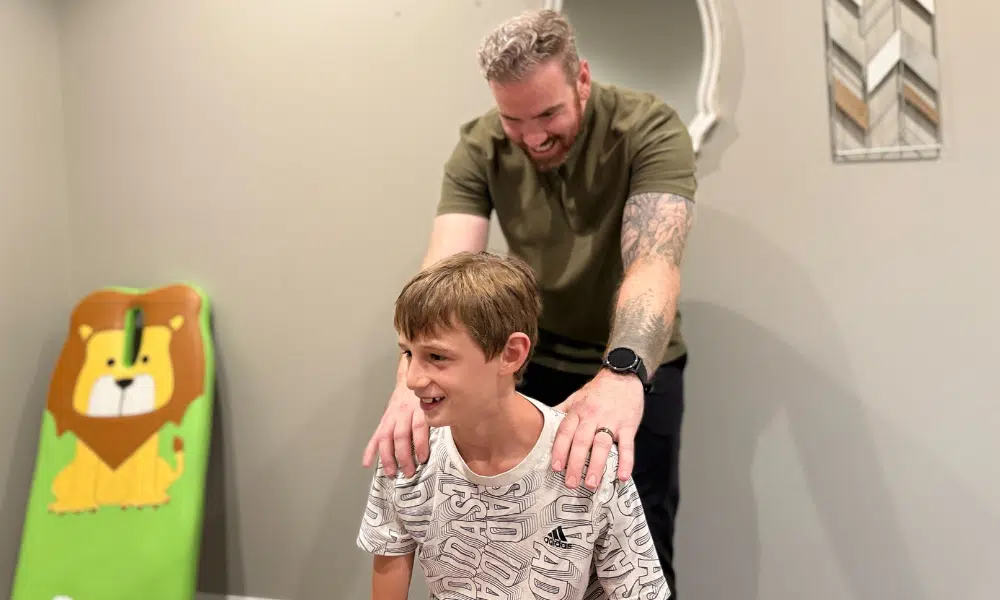Fainting or “passing out” from sudden drops in blood pressure accounts for nearly 1% of all pediatric emergency room visits each year.
Vasovagal syncope, VVS, is an abrupt loss of consciousness that is frightening yet usually benign. VVS temporarily reduces blood flow to the brain when the nervous system inappropriately widens blood vessels while slowing heart rate. Triggers like standing too long, sweltering rooms, skipped meals, having blood drawn, the sight of blood, or emotional distress can provoke episodes.
While generally considered benign by medical professionals, frequent fainting as a result of VVS can still have a diminishing effect on one’s quality of life. Fortunately, innovative sciences like functional neurology now recognize that dysfunctional signaling along the vagus nerve often underlies VVS.
In this article, we’ll address the role of the remarkable vagus nerve, the underlying factors behind vasovagal syncope, telltale symptoms, and drug-free Vasovagal Syncope treatments that address root causes rather than just manage episodes.
Understanding The Vagus Nerve
The vagus nerve is the longest of the 12 cranial nerves, wandering from the brainstem to organs in the abdomen. Its name derives from the Latin word “to wander,” which perfectly captures this vibrant pathway meandering to all life-sustaining organs. Beyond length, its functional diversity relinquishes the title of “master controller” for parasympathetic nervous system responses.
The parasympathetic system activates rest, digestion, recovery, growth, and immune enhancement, allowing us to rebuild between threats. Since over 75% of all parasympathetic nerve fibers belong to the vagus nerve, it is the critical pathway promoting relaxation, cardiovascular stability, metabolism, and mood regulation through neurotransmitters like acetylcholine and GABA.
Today, the vagus nerve is exposed to damage from modern exposures our ancestors never faced. Physical trauma at birth, like forceps extraction, can create misalignments and inflammation around delicate nerve fibers. Environmental toxins like mold, lead, and glyphosate irritate neural pathways, and viral infections readily damage sensitive nerve coatings.
Psychological trauma from stressful experiences can also impair vagal signaling over time.
For these reasons, understanding vagus nerve dysfunction as a byproduct of a “Perfect Storm” of modern exposures becomes critical in pursuing vasovagal syncope treatment.
What is Vasovagal Syncope?
Vasovagal syncope occurs when the nerves connecting the heart and blood vessels inappropriately trigger a sudden drop in systemic blood pressure and heart rate. This reduces blood flow to the brain, causing temporary loss of consciousness.
Under normal conditions, the autonomic nervous system elegantly coordinates signals to blood vessels, telling them to constrict or relax to maintain consistent blood flow and pressure. The vagus nerve plays a lead role, communicating back and forth between the brain, heart, blood vessels, and other organs.
In people prone to vasovagal syncope, this finely tuned system gets knocked off balance. The blood vessels relax too much, while the heart rate slows suddenly. The abrupt plunge in blood pressure reduces flow to the brain and leads to rapid-onset fainting.
Vasovagal syncope is the most frequent cause of fainting. It can happen at any age but most often first appears in children and young adults.
While passing out unexpectedly is always frightening, vasovagal syncope itself does not indicate any inherent abnormalities with the structure of the heart or blood vessels. Unlike cardiac or neurological causes of fainting, VVS stems from temporary miscommunication in an otherwise healthy system.
Vasovagal syncope is also known as reflex syncope since it involves an inappropriate reflexive response. When blood vessels relax excessively as the heart rate slows, reflex pathways overreact, resulting in fainting. Recognizing how modern factors like chronic stress impair smooth signaling offers solutions.
The Vagus Nerve and Vasovagal Syncope
The vagus nerve plays an integral role in regulating vascular stability and preventing abrupt drops in blood pressure. This remarkable nerve extends pathways between the brain, heart, blood vessels, gastrointestinal organs, and more.
Specifically, vagal fibers attach directly to the heart’s pacemaking cells while interfacing with the blood vessel lining. The vagus nerve coordinates moment-to-moment signals that raise or lower heart rate and constrict or relax blood vessels as needed. These actions maintain steady blood flow between the heart and brain during position changes and varying activity levels.
However, with dysfunction along vagal pathways, this finely tuned synchronization falters. Neural signals struggle to keep pace with real-time demands, and blood vessels may relax excessively while the heartbeat slows too much. This can cause drastic plummets in pressure, resulting in fainting episodes.
Vasovagal Syncope Treatment Testing
Beyond reviewing a patient’s medical history and performing a physical examination, physicians utilize additional tests, such as the tilt table test and the stress test, to determine the best syncope treatments and approaches.
Tilt Table Test
Tilt table testing provides direct evidence of susceptibility to vasovagal syncope by measuring vitals in response to upright positioning.
For this test, patients lie supine on a table with safety straps while nurses monitor heart rhythm and blood pressure. After 10-15 minutes tilted upright between 60-80 degrees, a positive response reproduces the precipitous drop in pressure and heart rate identical to spontaneous vasovagal syncope.
Exercise Stress Test
Exercise stress tests monitor heart rate and rhythm changes while walking on a treadmill with increasing speed and incline. This assesses how the cardiovascular system performs under physical duress.
For those with recurrent fainting, it helps determine if any arrhythmias are triggered that could cause syncope. However, since most vasovagal syncope stems from upright postural changes, not exercise, so these test results often come back normal. Still, evaluating the heart under exertion rules out primary electrical conduction issues.
These tests aim to confirm or deny a child’s inability to maintain vascular equilibrium despite homeostatic reflexes to increase heart rate. Some physicians also inject medications during the test to amplify blood vessel relaxation and provoke a syncope response.
Signs, Symptoms, and Risk Factors of Vasovagal Syncope
Recognizing the warning signs of impending vasovagal syncope allows time to prevent full fainting episodes. However, not all people experience telltale alerts before suddenly losing consciousness.
Common indicators in the minutes before fainting include:
- Nausea
- Weak, rubbery legs
- Flushed, sweaty skin
- Lightheaded wooziness
- Impaired vision or spots
If a child can lie down quickly upon these sensations, blood can return to the brain and avert syncope. However, bystanders will observe the rapid paling and draining color as the face turns white when pressure bottoms out. Then, loss of muscle tone results in abrupt slumping or knee buckling.
After fainting, the person remains unconscious for less than 20 seconds before returning to awareness, feeling quite fatigued. Since injury risk escalates for elders, prompt fall precautions and evaluation are vital.
Those especially prone to situational vasovagal syncope have triggers like:
- Low blood sugar states
- Exposure to medical procedures
- Prolonged standing in hot rooms
- Medications that lower blood pressure
- Dehydration and poor electrolyte balance
Therefore, monitoring contributing variables allows active prevention by averting high-risk environmental and physiological conditions when possible.
Lifestyle Changes and Natural Solutions
Implementing several lifestyle adjustments can drastically reduce vasovagal syncope episodes without medications. Strategies aim to stabilize blood sugar, expand blood volume, and improve vascular integrity.
- Eating smaller, frequent meals with clean proteins while minimizing inflammatory foods balances glucose levels.
- Loading electrolytes from sea salt, coconut water, or bone broth prevents low sodium triggering faintness.
- Compression leg garments improve venous return to the heart when standing.
- Tensing arm and leg muscles when feeling warning signs can temporarily maintain pressure.
- Adequate hydration from purified water maintains blood volume within safe limits.
Additionally, several natural compounds strengthen vascular lining, improve nerve conduction, and stimulate vagus nerve pathways. Magnesium relaxes smooth muscle spasms, while curcumin, omega-3s, and luteolin regulate endothelial inflammatory cascades.
Most importantly, directly assessing and addressing the root causes of dysfunctional vagus nerve communication through HRV analysis and Neurologically-Focused Chiropractic Care stops faintness at its origin. Collaborating with specialized functional neurologists trained in the nuances of vasovagal syncope provides a reasoned, scientific solution.
Finding Answers for Vasovagal Syncope
Vasovagal syncope can be disruptive and drastically reduce independence and quality of life. However, by implementing healthy lifestyle changes, proper nutrition, and Neurologically-Focused Chiropractic Care, vasovagal syncope treatment can mitigate these episodes without using medications.
If your child is still struggling with VVS despite traditional attempts to prevent it, there’s still hope. Advanced autonomics testing and targeted stimulation can help. You can get your child’s personalized solution by identifying and treating compressions that are irritating the vagus nerve and strengthening the nerves using HRV.
Visit our PX Docs directory to find a qualified, neurologically-focused chiropractor who understands the intimate complexities of vagal nerve dysfunction.





